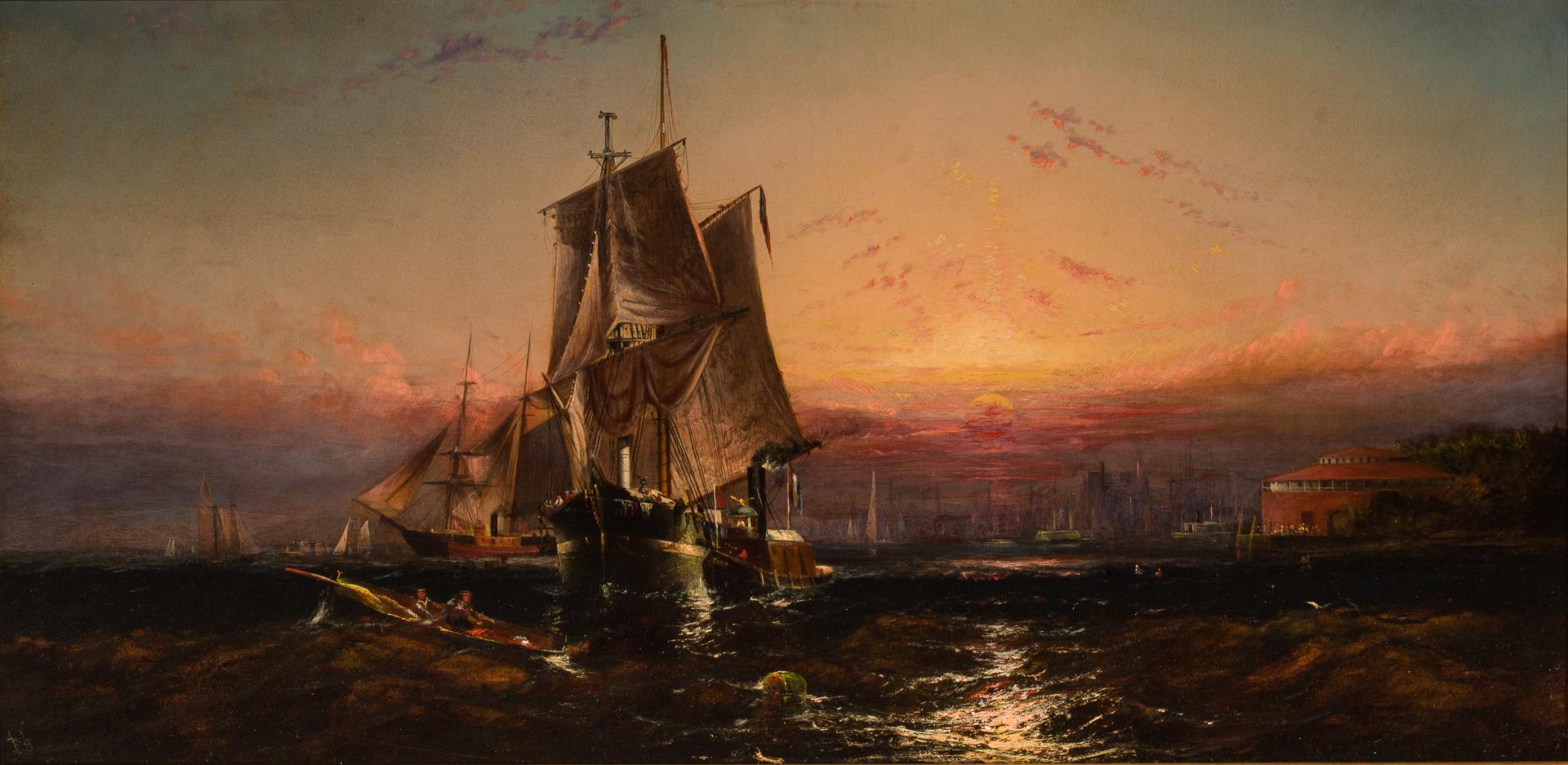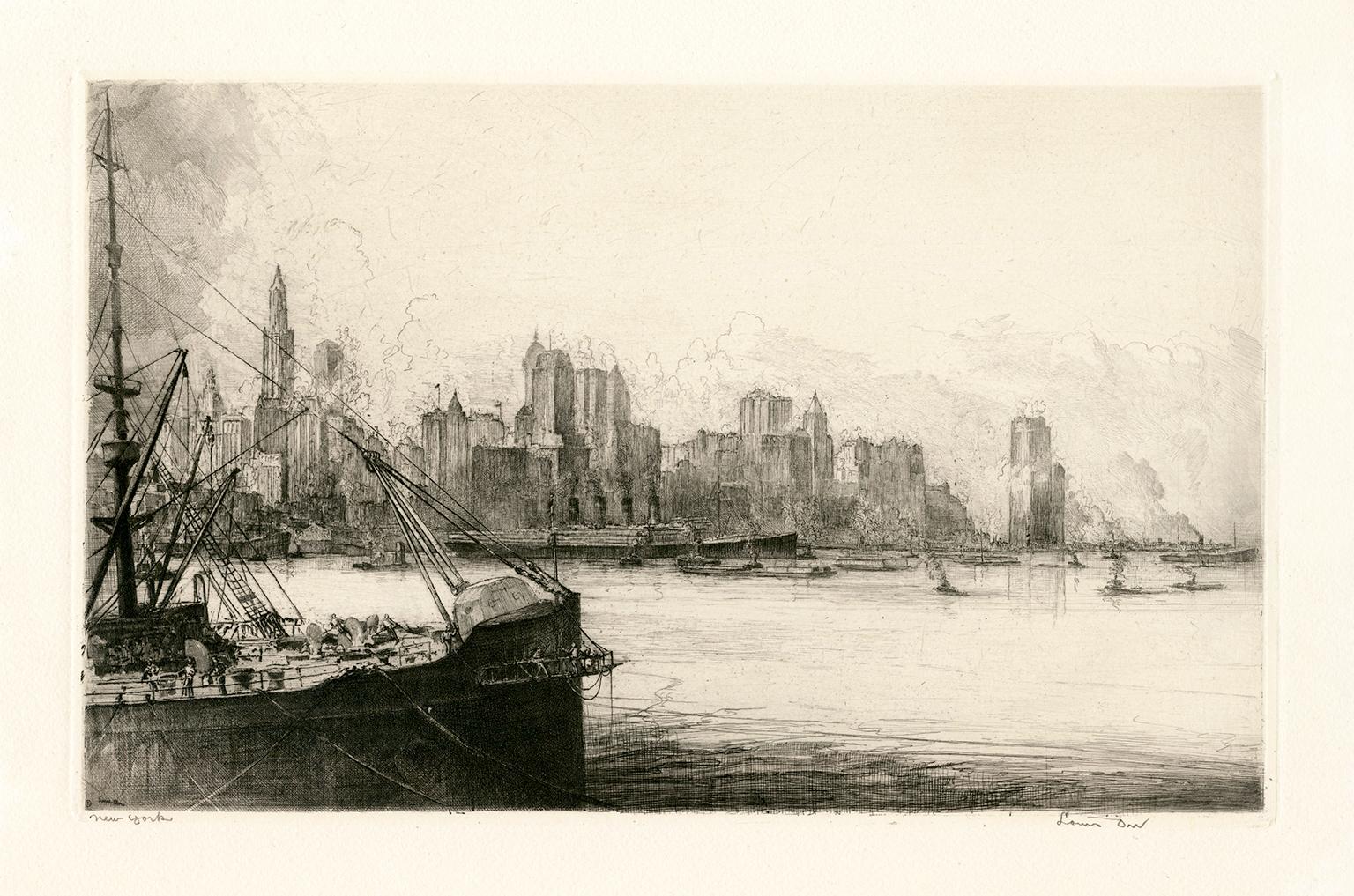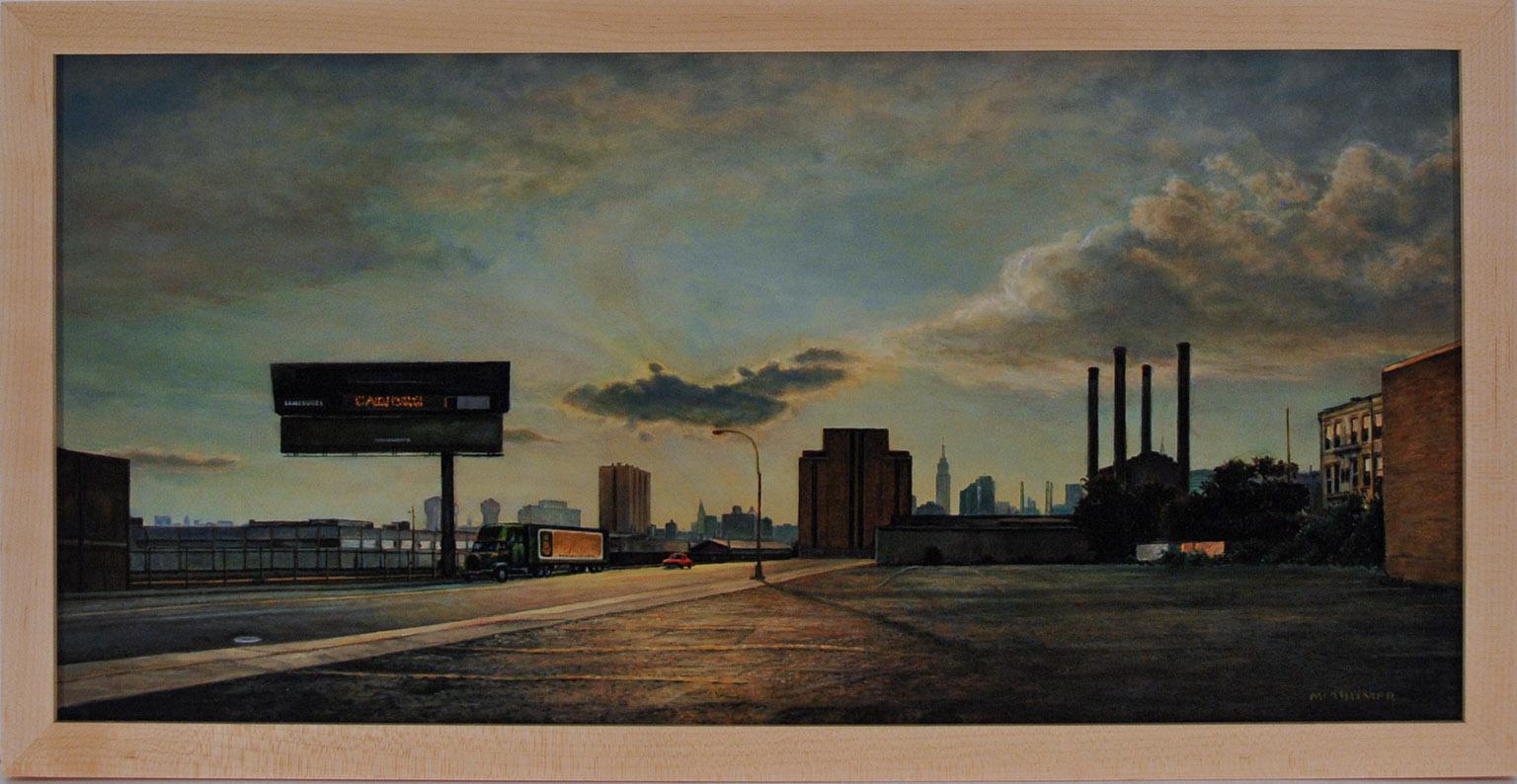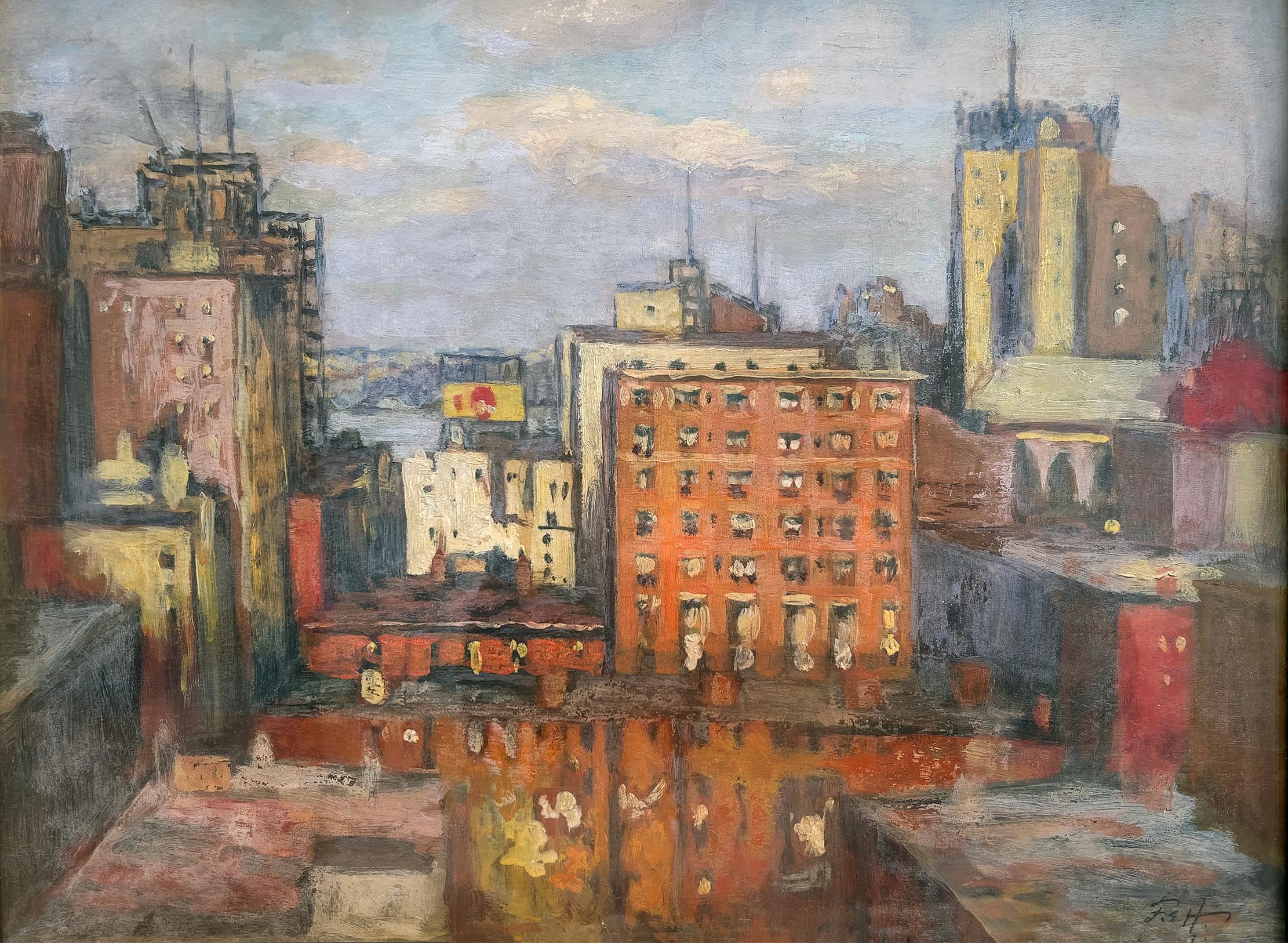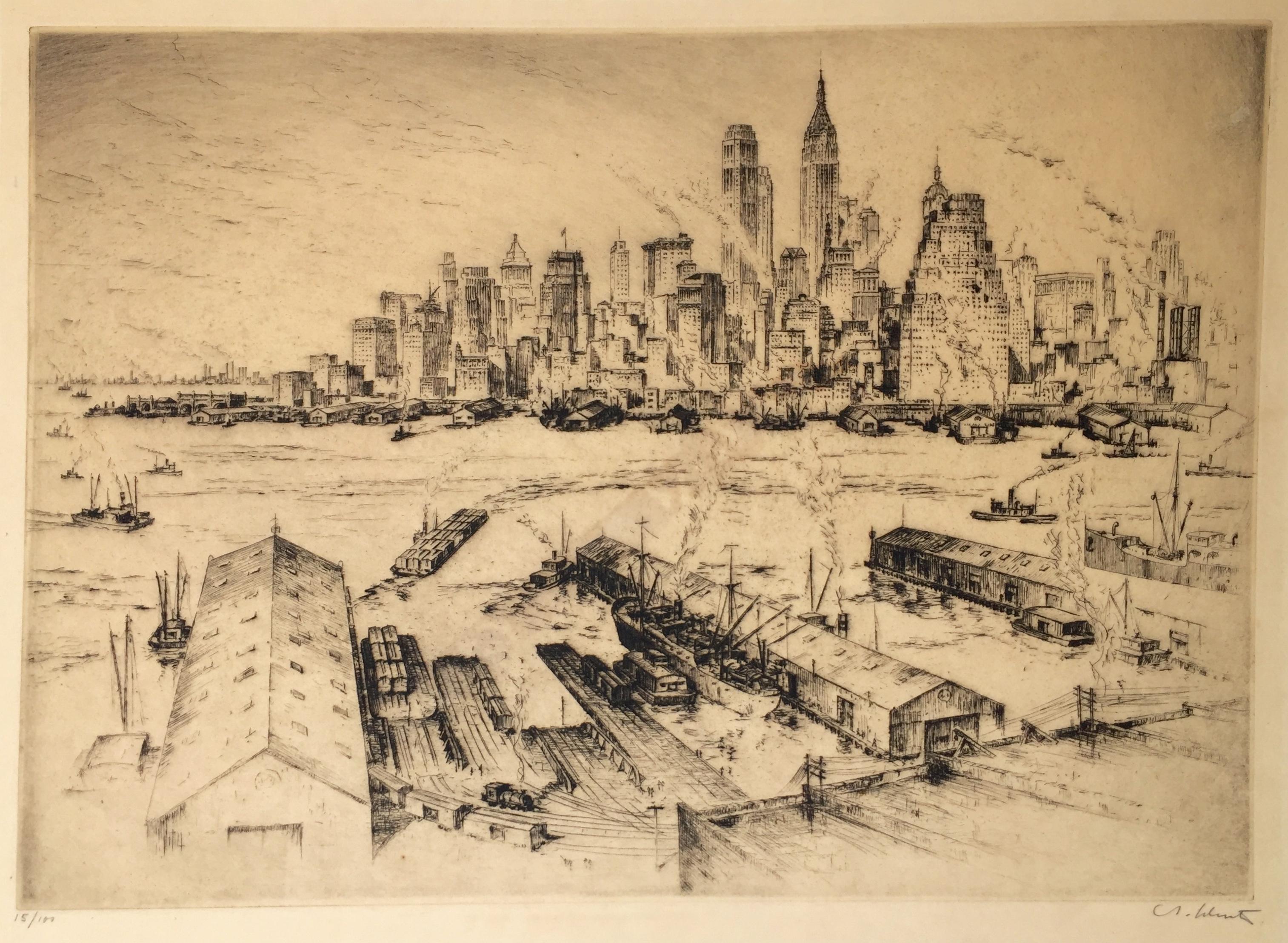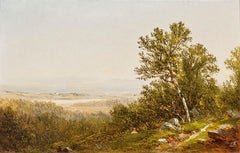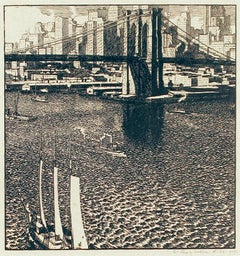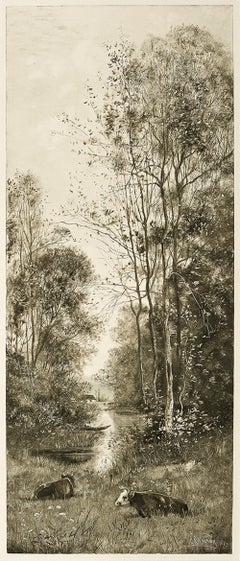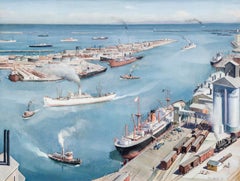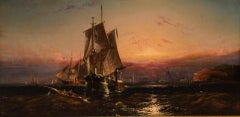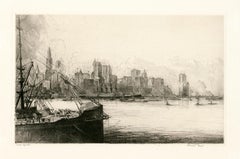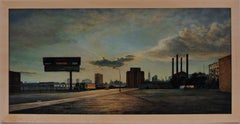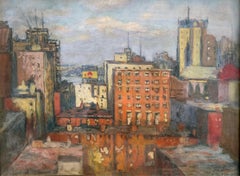Items Similar to New York from Hoboken
Want more images or videos?
Request additional images or videos from the seller
1 of 8
William Rickarby MillerNew York from Hoboken1851
1851
$110,000
£83,562.97
€96,251.22
CA$157,366.11
A$172,588.85
CHF 89,011.29
MX$2,061,719.88
NOK 1,128,933.96
SEK 1,059,068.14
DKK 719,067.36
About the Item
Signed (at lower left): W.R. Miller/ 1851
- Creator:William Rickarby Miller (1818 - 1893, American)
- Creation Year:1851
- Dimensions:Height: 17 in (43.18 cm)Width: 24 in (60.96 cm)Depth: 1.5 in (3.81 cm)
- Medium:
- Movement & Style:
- Period:
- Condition:
- Gallery Location:New York, NY
- Reference Number:Seller: APG 83141stDibs: LU236723102
About the Seller
5.0
Recognized Seller
These prestigious sellers are industry leaders and represent the highest echelon for item quality and design.
Established in 1952
1stDibs seller since 2010
35 sales on 1stDibs
Typical response time: 22 hours
Associations
Art Dealers Association of America
- ShippingRetrieving quote...Shipping from: New York, NY
- Return Policy
Authenticity Guarantee
In the unlikely event there’s an issue with an item’s authenticity, contact us within 1 year for a full refund. DetailsMoney-Back Guarantee
If your item is not as described, is damaged in transit, or does not arrive, contact us within 7 days for a full refund. Details24-Hour Cancellation
You have a 24-hour grace period in which to reconsider your purchase, with no questions asked.Vetted Professional Sellers
Our world-class sellers must adhere to strict standards for service and quality, maintaining the integrity of our listings.Price-Match Guarantee
If you find that a seller listed the same item for a lower price elsewhere, we’ll match it.Trusted Global Delivery
Our best-in-class carrier network provides specialized shipping options worldwide, including custom delivery.More From This Seller
View AllFigure in a Landscape
By David Johnson
Located in New York, NY
Signed (at lower right): DJ [monogram]; (on back): David Johnson 1865
Category
Mid-19th Century American Realist Landscape Paintings
Materials
Oil, Board
The Brooklyn Bridge
By Rudolph Ruzicka
Located in New York, NY
Born in Bohemia in what is now the Czech Republic, Rudolph Ruzicka emigrated to the United States when he was ten years old. His family settled in Chicago, where Ruzicka worked as a ...
Category
20th Century American Realist Landscape Prints
Materials
Engraving
Brookside
Located in New York, NY
Signed (at lower right): C A Walker
Category
Late 19th Century American Realist Landscape Prints
Materials
Monotype
San Pedro Harbor
By Paul Sample
Located in New York, NY
It is infrequent, to say the least, that a diagnosis of tuberculosis proves fortuitous, but that was the event, in 1921, that set Paul Starrett Sample on the road to becoming a professional artist. (The best source for an overview of Sample’s life and oeuvre remains Paul Sample: Painter of the American Scene, exhib. cat., [Hanover, New Hampshire: Hood Museum of Art, 1988] with a detailed and definitive chronology by Sample scholar, Paula F. Glick, and an essay by Robert L. McGrath. It is the source for this essay unless otherwise indicated.) Sample, born in Louisville, Kentucky, in 1896 to a construction engineer and his wife, spent his childhood moving with his family to the various locations that his father’s work took them. By 1911, the family had landed in Glencoe, Illinois, settling long enough for Paul to graduate from New Trier High School in 1916. Sample enrolled at Dartmouth College, in Hanover, New Hampshire, where his interests were anything but academic. His enthusiasms included the football and basketball teams, boxing, pledging at a fraternity, and learning to play the saxophone. After the United States entered World War I, Sample, to his family’s dismay, signed on for the Naval Reserve, leading directly to a hiatus from Dartmouth. In 1918 and 1919, Sample served in the U.S. Merchant Marine where he earned a third mate’s license and seriously contemplated life as a sailor. Acceding to parental pressure, he returned to Dartmouth, graduating in 1921. Sample’s undergraduate life revolved around sports and a jazz band he formed with his brother, Donald, two years younger and also a Dartmouth student. In November 1933, Sample summarized his life in a letter he wrote introducing himself to Frederick Newlin Price, founder of Ferargil Galleries, who would become his New York art dealer. The artist characterized his undergraduate years as spent “wasting my time intensively.” He told Price that that “I took an art appreciation course and slept thru it every day” (Ferargil Galleries Records, circa 1900–63, Archives of American Art, Smithsonian Institution, available on line).
In 1920, Donald Sample contracted tuberculosis. He went for treatment to the world-famous Trudeau Sanitorium at Saranac Lake, in New York State’s Adirondack Mountains for the prescribed regimen of rest, healthful food, and fresh air. Visiting his brother in 1921, Paul also contracted the disease. Tuberculosis is highly contagious, and had no certain cure before the development of streptomycin in 1946. Even for patients who appeared to have recovered, there was a significant rate of recurrence. Thus, in his letter to Price, Sample avoided the stigma conjured by naming the disease, but wrote “I had a relapse with a bad lung and spent the next four years hospitalized in Saranac Lake.” The stringent physical restrictions imposed by adherence to “the cure” required Sample to cultivate an alternate set of interests. He read voraciously and, at the suggestion of his physician, contacted the husband of a fellow patient for instruction in art. That artist, then living in Saranac, was Jonas Lie (1880–1940), a prominent Norwegian-American painter and an associate academician at the National Academy of Design. Lie had gained renown for his dramatic 1913 series of paintings documenting the construction of the Panama Canal (The Metropolitan Museum of Art, New York; United States Military Academy, West Point, New York). Primarily a landscape artist, Lie had a particular affinity for scenes with water. His paintings, impressionistic, atmospheric, and brushy, never strayed from a realistic rendering of his subject. Sample regarded Lie as a mentor and retained a lifelong reverence for his teacher. Sample’s early paintings very much reflect Lie’s influence.
`
In 1925, “cured,” Sample left Saranac Lake for what proved to be a brief stay in New York City, where his veteran’s benefits financed a commercial art course. The family, however, had moved to California, in the futile hope that the climate would benefit Donald. Sample joined them and after Donald’s death, remained in California, taking classes at the Otis Art Institute in Los Angeles. In Sample’s account to Price, “I couldn’t stomach the practice of painting a lot of High Sierras and desert flowers which seemed to be the only kind of pictures that were sold here so I got a job teaching drawing and painting at the art school of the University of Southern California.” Initially hired as a part-time instructor, Sample progressed to full-time status and ultimately, by the mid-1930s, to the post of Chairman of the Fine Art Department. Sample, however, did not want to wind up as a professor. “Teaching is all right in small doses,” he wrote, “but I have a horror of drifting into being a college professor and nothing more.” At the same time as he taught, Sample began to exhibit his work in a variety of venues at first locally, then nationally. Though he confessed himself “a terrible salesman,” and though occupied with continued learning and teaching, Sample was nonetheless, ambitious. In 1927, he wrote in his diary, “I am eventually going to be a painter and a damned good one. And what is more, I am going to make money at it” (as quoted by Glick, p. 15). In 1928, Sample felt sufficiently solvent to marry his long-time love, Sylvia Howland, who had also been a patient at Saranac Lake. The Howland family were rooted New Englanders and in summertime the Samples regularly traveled East for family reunion vacations.
While the 1930s brought serious hardship to many artists, for Paul Sample it was a decade of success. Buttressed by the financial safety net of his teacher’s salary, he painted realist depictions of the American scene. While his work addressed depression-era conditions with a sympathetic eye, Sample avoided the anger and tinge of bitterness that characterized much contemporary realist art. Beginning in 1930, Sample began to exhibit regularly in juried exhibitions at important national venues, garnering prizes along the way. In 1930, Inner Harbor won an honorable mention in the Annual Exhibition of the Art Institute of Chicago. That same year Sample was also represented in a show at the Albright-Knox Gallery in Buffalo and at the Biennial Exhibition of the Corcoran Gallery of Art, Washington, D.C. In 1931, Dairy Ranch won the second Hallgarten Prize at the Annual Exhibition of the National Academy of Design, in New York. Sample also made his first appearances at the Carnegie Institute, Pittsburgh, and The Pennsylvania Academy of the Fine Arts, Philadelphia. In 1936, Miner’s Resting won the Temple Gold Medal at the Pennsylvania Academy’s Annual Exhibition. Always interested in watercolor, in 1936, Sample began to send works on paper to exhibitions at the Whitney Museum, New York.
While participating in juried exhibitions, Sample also cultivated commercial possibilities. His first New York art dealer was the prestigious Macbeth Gallery in New York, which included his work in a November 1931 exhibition. In 1934, Sample joined the Ferargil Galleries in New York, after Fred Price arranged the sale of Sample’s Church Supper to the Michele and Donald D’Amour Museum of Fine Arts in Springfield, Massachusetts. In 1937, The Metropolitan Museum of Art purchased Sample’s Janitor’s Holiday from the annual exhibition of the National Academy of Design, a notable honor.
As prestigious as this exhibition schedule may have been, by far Sample’s most visible presence in the 1930s and 1940s was the result of his relationship with Henry Luce’s burgeoning publishing empire, Time, Inc. Sample’s first contribution to a Luce publication appears to have been another San Pedro...
Category
20th Century American Modern Landscape Paintings
Materials
Canvas, Oil
Street Scene: "King George Dies"
By Thomas Fransioli
Located in New York, NY
Fransioli was born in Seattle, Washington, and received a degree in architecture from the University of Pennsylvania in 1930. He worked with John Russell Pope on plans for the exhibition galleries at the National Gallery of Art in Washington, D.C., which he pinpointed as the beginning of his interest in painting. World War II interrupted a promising career in architecture. Fransioli served in the Pacific Theatre from 1943 until 1946, and was among the first American soldiers to survey Hiroshima after the atomic bomb’s detonation in August 1945. He returned to civilian life and took up painting, basing himself in Boston, but working up and down the eastern seaboard.
Thomas Fransioli’s cityscapes are crisp and tidy. Buildings stand in bold outline, their forms squarely defined by stark light and long shadows. Saturated color permeates every corner of his canvases, from vibrant oranges and greens to smoky terra cottas and granites. Even the trees that line Fransioli’s streets, parks, and squares are sharp and angular, exactly like those in an architect’s elevation rendering. But Fransioli’s cities often lack one critical feature: people. His streets are largely deserted, save for parked cars and an occasional black cat scurrying across the pavement. People make rare appearances in Fransioli’s compositions, and never does the entropy of a crowd overwhelm their prevailing sense of order and precision. People are implied in a Fransioli painting, but their physical presence would detract from the scene’s bleak and surreal beauty.
Magic Realism neatly characterizes Fransioli’s artistic viewpoint. The term was first broadly applied to contemporary American art in the 1943 Museum of Modern Art exhibition, American Realists and Magic Realists. As exhibition curator Dorothy Miller noted in her foreword to the catalogue, Magic Realism was a “widespread but not yet generally recognized trend in contemporary American art…. It is limited, in the main, to pictures of sharp focus and precise representation, whether the subject has been observed in the outer world—realism, or contrived by the imagination—magic realism.” In his introductory essay, Lincoln Kirstein took the concept a step further: “Magic realists try to convince us that extraordinary things are possible simply by painting them as if they existed.”
This is Fransioli, in a nutshell. His cityscapes exist in time and space, but certainly not in the manner in which he portrays them.
Fransioli—and other Magic Realists of his time—was also the heir to Precisionism, spawned from Cubism and Futurism after the Great War and popularized in the 1920s and early 1930s. While Fransioli may not have aspired to celebrate the Machine Age, heavy industry, and skyscrapers in the same manner as Charles Sheeler, his compositions tap into the same rigid gridwork of the urban landscape that was first codified by the Precisionists.
During the 1950s, Fransioli was represented by the progressive Margaret Brown...
Category
20th Century American Realist Paintings
Materials
Canvas, Oil
Tree and Fence, East Hartford, Connecticut (New England Landscape)
By Charles De Wolf Brownell
Located in New York, NY
Watercolor and gouache on paper
Category
Mid-19th Century American Realist Landscape Drawings and Watercolors
Materials
Watercolor, Gouache
You May Also Like
New York Harbor Near Castle Garden
By Elisha Taylor Baker
Located in Costa Mesa, CA
In this atmospheric and luminous work by E.T. Baker, the busy port of New York hosts a huge number of ships coming and going near the Battery and the famous landmark of Castle Garden...
Category
1860s Other Art Style Landscape Paintings
Materials
Canvas, Oil
New York (from Ports of America)
By Louis Orr
Located in Myrtle Beach, SC
Louis Orr, 'New York' (from the portfolio 'Ports of America', published by Yale University Press, 1928), etching, 1925, edition not stated. Signed and titled in pencil. Signed in the...
Category
1920s Realist Landscape Prints
Materials
Etching
Long Island City
By Frederick Mershimer
Located in New York, NY
Long Island City
Contemporary artist Frederick Mershimer created this oil painting on a wooden panel in 2005. The painting (wood panel) is 10.25 x 21.25 inches (26 x 54 cm). This ...
Category
21st Century and Contemporary American Realist Landscape Paintings
Materials
Oil, Wood Panel
New York Skyline the West Side with Hudson River - Vintage New York
By Frank S. Hermann
Located in Miami, FL
Rooftop view of the upper West Side Manhattan as it looked in the 1930s. There is a rough indication of a billboard and a glimpse of the Hudson River. The cluster of buildings depic...
Category
1930s American Impressionist Landscape Paintings
Materials
Oil, Gouache, Board
MANHATTAN
By Anton Schutz
Located in Santa Monica, CA
ANTON SCHUTZ
MANHATTAN c 1940
Etching, signed in pencil, edition 100, no. 15/100. On thin simili-japan paper. Very slight toning around plate mark. Remnants of old tape on verso, s...
Category
1940s American Realist Landscape Prints
Materials
Etching
New York Central Home Port
By Nicholas Berger
Located in Greenwich, CT
Nicholas Berger Biography
American, b. 1949
In his more than three decades as an artist, Nicholas Berger (b. 1949) has created an outstanding body of work that continues to evolve a...
Category
2010s American Realist Landscape Paintings
Materials
Oil, Panel
More Ways To Browse
Huge Garden Painting
Italian City Oil Painting
James Cobb
Jan Van Goyen
John Fabian Carlson
Josep Amat
Ken Green
Landscape Painting Signed James
Large Oil Painting Waves
Les Parson
Lily Pad Oil Paintings
Mahonri Young
Mark Rowland
Maui Oil Paintings
Mid Century Fence
Miss Me
Mt Tamalpais
Museum Brushstrokes Collection Claude Monet
